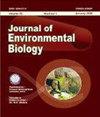Desulfurization of coal using heterogeneous microbial species isolated from acid mine drainage, Talabira Coal Mines, Sambalpur, Odisha
IF 0.6
Q4 ENVIRONMENTAL SCIENCES
引用次数: 0
Abstract
Aim: The present study aims to assess the coal desulfurizing efficiency of heterogenous microbial consortia isolated from drainage water of Talabira Coal Mines, Sambalpur, Odisha. Methodology: Microbial species in the mine drainage water were isolated and cultured using 9K+ medium. Identification of microbial species was performed by the amplification of 16S rDNA. The heterogeneous microbial consortia were incubated with pulverized coal to assess their desulphurizing efficiency. Results: The proximate analysis of the coal sample revealed 34.92% fixed carbon, 9.01% moisture, 33.38% ash and 25.44% volatile matter. After incubation of the pulverized coal with isolated and cultured heterogeneous microbial species from MDW water of Talabira coal mines area, Odisha for 24 days in aerobic condition, the total sulphur content was reduced from 2.86% to 1.61%, while significant removal of pyritic Sulphur (48%) was obtained from 1.72% to 0.91%. However, no remarkable reduction was seen in the case of organic Sulphur. Interpretation: The results showed that drainage water of Talabira Mines inhabits numerous potential desulfurizing bacterial species that need further isolation, characterization, and process optimization to achieve optimal sulphur removal efficiency. Key words: Autotrophic bacteria, Coal, Microbial desulfurization利用从奥迪沙邦桑巴尔布尔塔拉比拉煤矿酸性矿井排水中分离出的异源微生物物种进行煤炭脱硫
目的:本研究旨在评估从奥迪沙邦桑巴尔普尔的塔拉比拉煤矿排水中分离出来的异源微生物群的煤炭脱硫效率。研究方法使用 9K+ 培养基分离和培养矿井排水中的微生物物种。通过扩增 16S rDNA 鉴定微生物物种。将异质微生物群与煤粉一起培养,以评估其脱硫效率。结果煤样的近似分析显示,固定碳占 34.92%,水分占 9.01%,灰分占 33.38%,挥发物占 25.44%。在有氧条件下,将煤粉与从奥迪沙邦塔拉比拉煤矿区 MDW 水中分离培养的异源微生物菌种培养 24 天后,总硫含量从 2.86% 降至 1.61%,而亚硫酸盐硫(48%)的去除率从 1.72% 降至 0.91%。不过,有机硫的含量并没有明显降低。解释:结果表明,塔拉比拉矿区的排水中栖息着许多潜在的脱硫细菌,需要进一步分离、鉴定和优化工艺,以达到最佳的脱硫效率。关键词自养菌 煤炭 微生物脱硫
本文章由计算机程序翻译,如有差异,请以英文原文为准。
求助全文
约1分钟内获得全文
求助全文
来源期刊

Journal of environmental biology
ENVIRONMENTAL SCIENCES-
CiteScore
1.70
自引率
0.00%
发文量
92
审稿时长
3 months
期刊介绍:
Information not localized
 求助内容:
求助内容: 应助结果提醒方式:
应助结果提醒方式:


